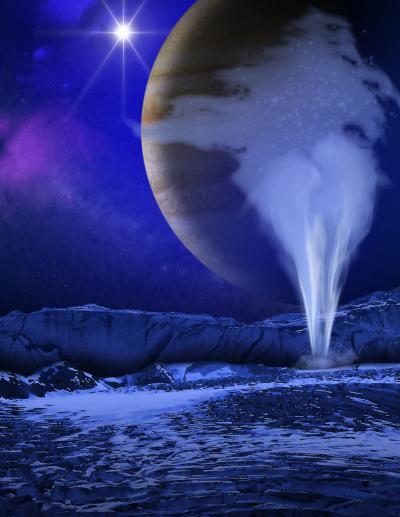Astronomers have discovered huge active plumes containing water vapour being released from the surface of Jupiter's moon Europa.
Jupiter's moon Europa has been a focus of extraterrestrial research for some time now as there were clear indications that it harbors a liquid ocean beneath its icy crust. Lorenz Roth of the Southwest Research Institute in San Antonio, Texas and Joachim Saur of the University of Cologne have used the NASA/ESA Hubble Space Telescope to prove that there is water vapor erupting near its south pole.
The water plumes are in comparison to earth geysers immensely large and reach heights of approximately 200 km. Europa has a circumference of 3200 km and is thereby comparable in size with the Moon.
"Water is generally considered a basic prerequisite for life – at least as we know it on earth," says Lorenz Roth, who was in charge of analyzing the observations and has been working at the Southwest Research Institute in America. "For this reason, the discovery of a water vapor plumes on the moon Europa has increasingly become a focus of extraterrestrial research."
The plumes eject material from the surface which will make further investigations of the moon Jupiter much easier in the future.

Artistic rendition of Europa. Credit: Kurt Retherford, Southwest Research Institute
"We have been advancing the search for water and water plumes with multiple Hubble campaigns," says Saur. "However, it was only after a camera on the Hubble Space Telescope in one of the last Space Shuttle Missions was repaired that we were able to achieve enough sensitivity to observe the fountains."
The water plumes could only be seen in the observations when Europe was in a position in its orbit where the moon was furthest away from Jupiter. That means that the activity of the fountain varies temporally. Europa's orbit is not quite circular but slightly elliptical. When Europa is furthest away from Jupiter in its orbit, the tidal forces cause the huge fractures in Europa's ice surface to widen from which presumably the vapor is released.
Similar plumes of water vapor were discovered by the Cassini spacecraft on the Saturn moon called Enceladus. The activities there are similar to those on Europa during its orbit around its mother planet.






Comments